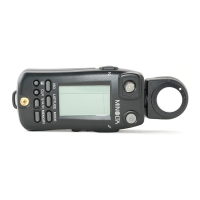E18
Preparations
E19
Basic Operation
Here we explain the basics of using the MINOLTA FLASH METER VI
to take exposure readings.
Select a measuring method
● Flash light refers to artificial momentary lighting from light sources such
as electronic flashes, strobe flashes, and speed lights.
● Ambient light refers to continuous lighting from sources such as natural
light (sunlight) and electric lights (including fluorescent lights).
● In either case, both incident-light exposure readings and spot-light
exposure readings can be made.
Spot (reflected-light) readings
Spot (reflected-light) exposure readings directly measure the amount of
light (luminance) reflected from the subject to the camera. Unlike the case
of incident-light readings, this method does not rely on the assumption of a
standard subject reflectance of 18%. Based on the measured amount of
light falling on the subject, the meter calculates the appropriate exposure
value for reproducing the subject on film at a suitable medium density
(midtone). This means that in Spot (reflected-light) readings, all subjects,
regardless of their reflectance, i.e. regardless of whether they are bright or
dark (white or black), will be reproduced at the same tonal density
(midtone). For this reason, when making Spot (reflected-light) exposure
readings, it is important to decide which area of the subject to measure,
since the reflectance will generally vary quite widely over the composition
under different conditions.
There are various advanced Spot (reflected-light) readings, such as the
highlight standard exposure method, where an exposure reading is taken
of a bright (white) part of the composition; the shadow standard exposure
method, where a dark (black) part of the composition is measured; and a
method for determining exposure by evaluating the contrast of the
subject and then forecasting how it will come out on film. To make full
use of Spot (reflected-light) readings, refer to specialist books and photo
magazines. You will find that selective metering can give you very
precise control over exposure.
Are you using a still camera?
Are you using a cine camera?
With a still
camera
With a cine
camera
Alt mode
Alt mode
Select TIME (P.72)
Select CINE (P.72)
Type of light source to
measure
Ambient light
Flash light
(mixed
light)
Are you using a sync cord?
With a sync
cord
Without a
sync
cord
AMBI
mode
(p. 20)
CORD
mode
(p. 27)
NON CORD
mode
(p. 32)
AMBI
mode
(p. 24)
flashmetervieng.qx3302.12.259:21PMページ18

